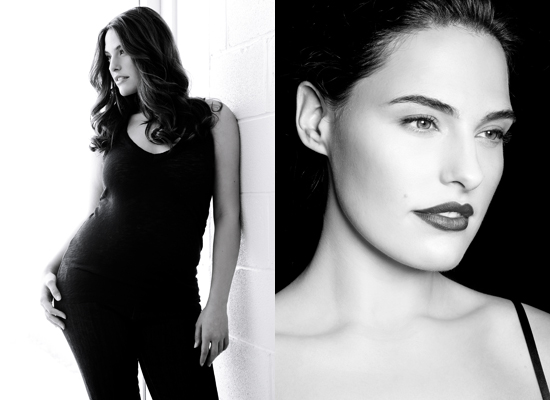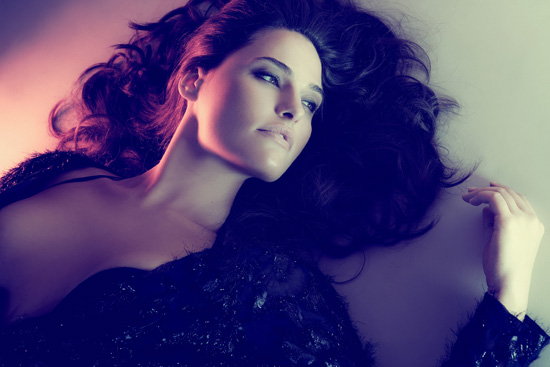Curvy assets in mainstream media have just set off another round of debate and controversy. Plus models, skinny models: what happened to just straight up models who are beautiful? We long for the golden days of the Supermodel. I grew up with Cindy, Christy (Turlington and Brinkley), Naomi, Linda and Elle. A few years ago when Vogue featured some of those familiar faces on the cover, people in fashion swooned with a bittersweet nostalgia. Gorgeous women with gorgeous bodies who were celebrities in their own right. These are the women I thought of when, six years ago, a photographer mistook me for a plus model he'd recently worked with and suggested that I submit some photos to an agency. I had never heard of plus and was skeptical that my face and those faces, or more specifically my body and their bodies had any business falling together under the label of 'Model.' I was wrong.

The blogger
When I entered the industry it was obvious that those supermodel days were over. Instead there was an ever-turning machinery that churned out ever-younger, ever-thinner anonymous lineups that briefly fit standardized measurements. It's not just the supermodel that's dead, but also the career model. The exception being catalog models aging well enough to transition steadily through the commercial divisions until they arrive at the "sophisticated."
Modeling, as an act of employment to sell goods, is a by-product of capitalism, the industrial revolution, and the rise of American commercial life. At first there were drawings, echoing the up-do and heavy bosom of the Gibson Girls, then full color illustrations of full-bodied, rosy-cheeked American ideals. In the post-war era, young women of a certain class and race could have their go at modeling for a time until they married or had children. They were not supporting themselves with this income, it would have been considered debasing or licentious to do so, smacking too much of that other bodily profession.

But as the decade wore on Vogue covers gained popularity and something shifted. Women were entering the workforce en masse and contemplating larger liberations. Enter Twiggy. The era of the Supermodel was dawning. Her body fluctuated with our standards of beauty. Sometimes we wanted her super thin, sometimes we wanted her super sensuous but always we wanted her super beautiful. Casting our notions and desires onto that body, always asking what her hip and bust measurements say about us at large, from our Jane Fonda aerobics to our heroin chic. Supermodels were represented the most desired female ideal for both men and women. Something that, in order to sell issues and products, was an aspiration worth striving for because on some level you felt it was accessible or identified with it. These were women, young but adult, beautiful but well-spoken. With ideas, opinions, and experiences that we wanted to know. Not just supermodels but role models to some extent.
Some crossed over into mainstream media, branding themselves, acting in film or appearing on television. But things were shifting again. We went Kate Moss and we never went back: the bony, androgynous silhouette ruled. At the same time film was giving up its ghost to digital. While photographs are always an illusion of lighting, makeup, hair, and styling, suddenly it was possible to drastically alter the body itself. Re-touching on film was prohibitive in both cost and time. So the models had to be great: great hair, great skin (read great nutrition and fitness), great movement and confidence (read maturity). Sample sizes were a size 6 and 8 for a reason. Today, each and every image is altered in post-production to better fit the aesthetic ideal, using one head on another body, smoothing over all "imperfections." More like painting than photography, the body is negotiable. Finally, movie stars dominated the cover of magazines and campaigns--the new ideal, in body, fashion, and lifestyle. We see them in films, read their interviews in print, follow their trials in tabloids, and identify with them personally.
And so the new model: amazingly young, predominately eastern European, incredibly thin. Alienating and anonymous to the general population, they are interchangeable bodies at 5'9", 30-23-30. So we debate about the health of these girls--sometimes 13 or 14 years old, and eating disorders, and media responsibility, and our impressionable young women. All arising from the expectation that models be little more than hangers for the clothes they display. This has been the longest span of fashion history enthralled to one severe ideal.
Then we sigh over the death of the Supermodel. With perhaps only Giselle waving the contemporary banner, followed by a few other Victoria Secret models recognizable by face but not name to the public. These ladies walked Prada's runway last season, celebrated for their slightly curvier frames, while Marc Jacobs put Laetitia Casta and Elle Macpherson back on the Vuitton runway, craving bigger personalities to fill out the label. These are notable because they are exceptions.
The pendulum is stuck at waif, so we've created an opposite alternative in "plus" modeling. A response to the consumer whose own average size has settled at a 14 and beyond. The logic goes, if a size 0 sells to a size 8 or 10, then a size 12 should sell to a size 18 or 20. But then what does a "plus" model signify? If we range in size from 8 to 14, we actually represent not just the average woman, but the upper end of the old model sizes as well.
I have been consistently impressed with the devoted followers of plus modeling. Some of our ranks have gained something akin to celebrity status. Crystal Renn and Kate Dillon are incredibly popular to people looking for not just an alternative body type, but for a personality and a role model. In general we enter the industry post-adolescence, have a longer career span, and a voice--a throwback to the glory days. But as the "alternative" we are politicized to an extent and try to represent, from inside the industry, all those who fall outside the extreme standards of fashion modeling today.
It seems obvious at this point that the modeling industry, and the fashion industry at large, has developed a sort of personality disorder trying to be all things to all consumers and all advertisers while losing its center--the beautiful woman--in the process. The woman who inspires our ideal: beauty of body, mind, and spirit.